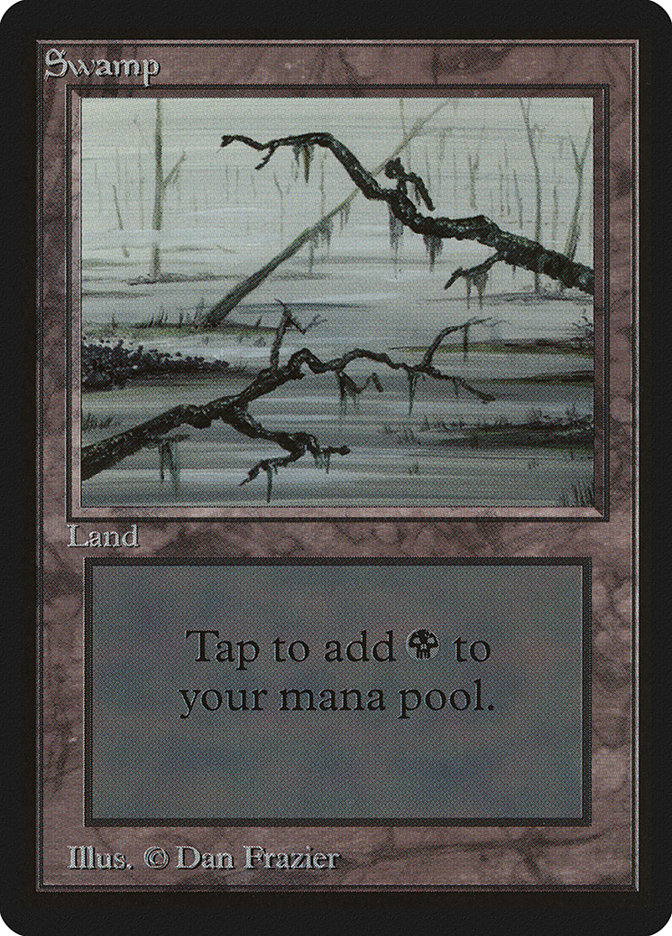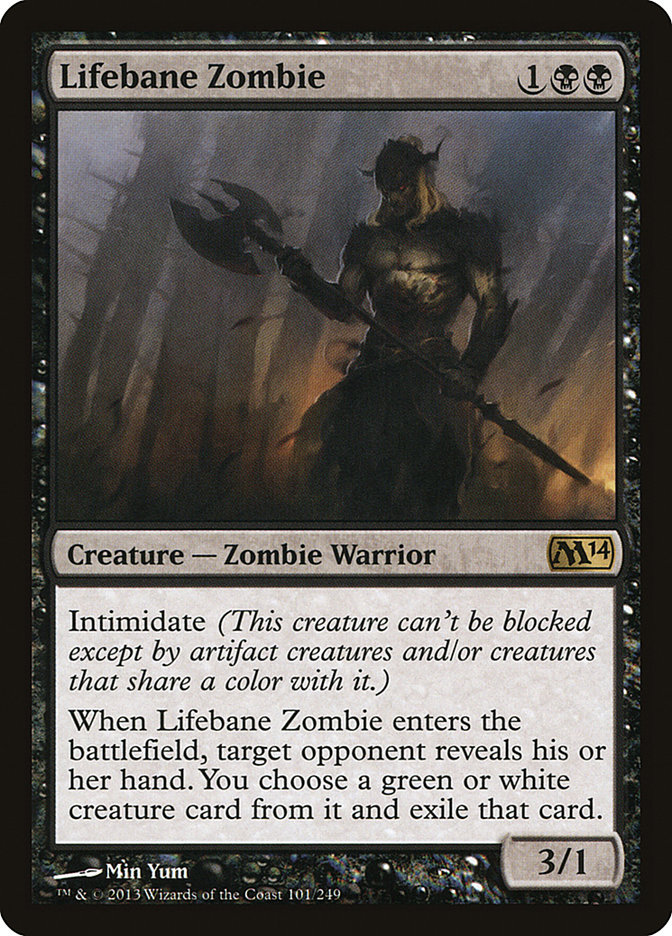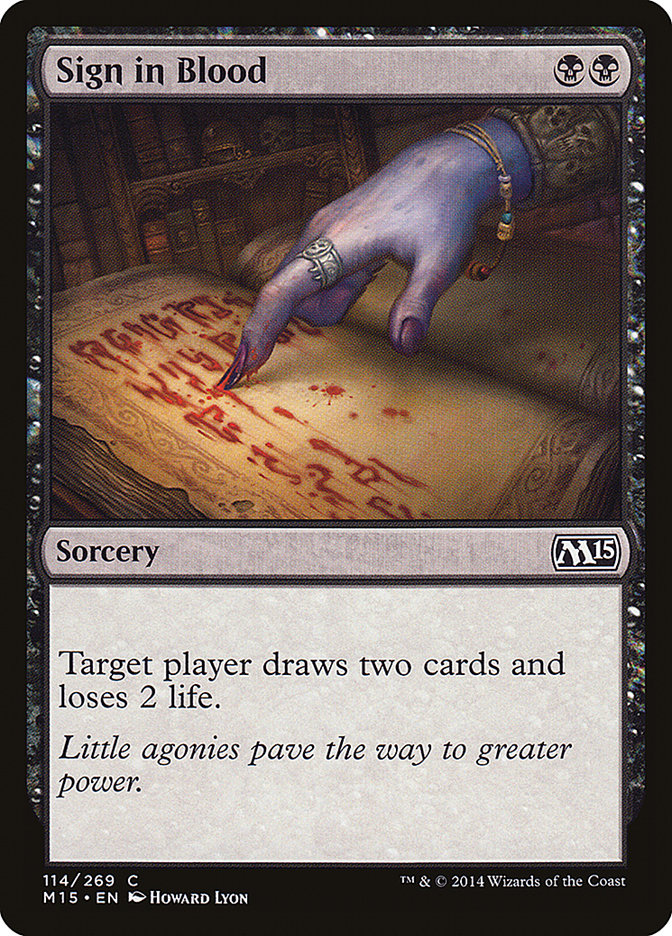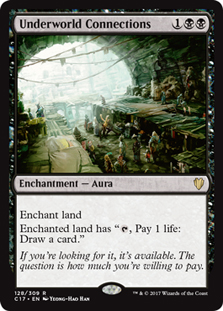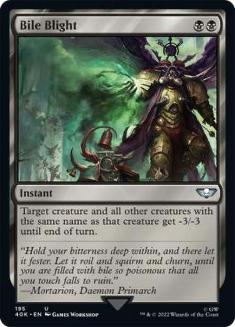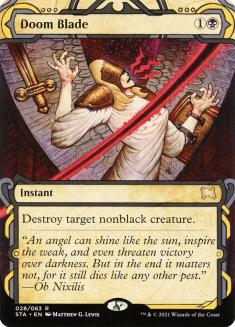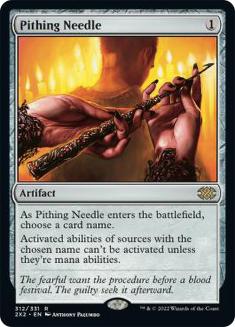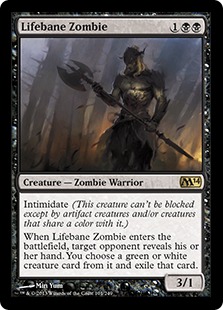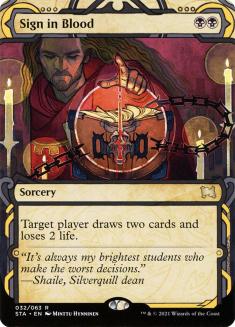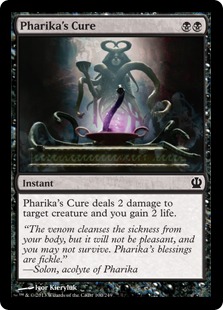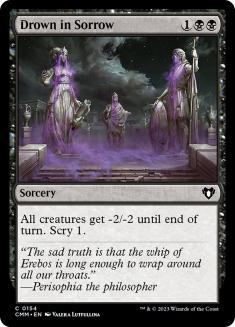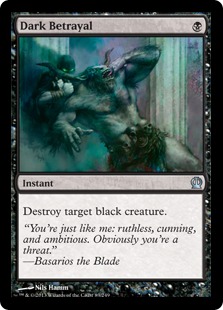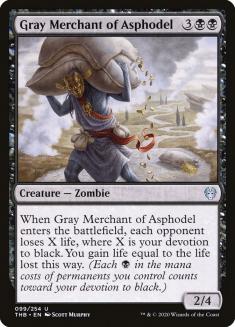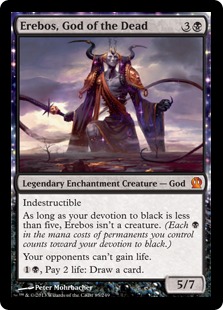For this article, I decided I would talk about a deck that almost no one is writing about and that you’ve almost certainly not heard about.
That’s right, it’s Mono-Black Devotion.
There was a fundraiser tournament for Mariah Pagliocco held two weekends ago. It was a successful event raising north of $15,000 for the cause. While we were all there to support
Mariah and Tony we were also there to compete in the event, which I was able to win. Enough has been said about how great the Magic community can be and
is. I suggest that we all try to remember that.
Here’s the list I used:
Creatures (16)
Lands (25)
Spells (19)

I’ve done especially well in Standard lately, and each time but one I’ve played with Gray Merchant of Asphodel. Now, I shudder to think that this might
make me a Standard expert, but I (perhaps feebly) hope it just makes me a Thoughtseize expert. And, while I was happy enough to play Mono-Blue Devotion
when I thought the metagame had turned sour for black, I was not actually pleased with how the matchup felt from the blue side so I was more than happy to
return to my beloved swamps when I could.
As you can see, I played the full twenty swamps. Sumpf, Marais, Palude, Pantano or just plain Swamp–call them what you will. I just wanted to
get black mana, and black mana is what I got. I chose to run zero temples to facilitate the Sign in Bloods. In the future, if I could stomach testing
Standard, I’d try out one temple and see how bad I felt when I drew it. Not playing 26 total lands also makes running temples less of a necessity, but the
extra card-draw granted by Sign in Blood makes the temples filtering somewhat unnecessary.
I’ve written extensively about the subject, and while the deck has changed with each new set coming out, the strategies remain largely unchanged. For
anyone competing at the Pro Tour, I highly recommend these two pieceshere and here. My feelings are that Standard games are not really as
decision-intensive as other formats and that it makes the most sense to simply play the cards that are the best. It is also my opinion that Lifebane Zombie
is an absurd card. Let’s get a look:
This card is absurd at three mana, and if it cost BBB to cast, I wouldn’t have been that surprised either. I’ve written about it before, and I’m happy
enough to write about it again. The existence of this card in the format more or less precludes me (and other likeminded players) from playing with white
or green creatures, and of course, I suggest you take the same route. I simply can’t advise it! The fact that the control decks sometimes board in big
white creatures is somewhat irrelevant, but being able to attack their planeswalkers unimpeded and never tangle with a Mutavault is relevant.
Lifebane Zombie is simply a masterpiece.
Let’s get to it then. First, we’ll take a look at the two new inclusions in the deck, and a couple that didn’t quite make the cut:
Okay, how is this different than Read the Bones? Well, for starters we don’t get to Scry 2. Bummer. The card costs BB instead of 2B, but we’ve dealt with
that issue for the most part by building our deck slightly differently. However, we can target our opponents to finish them off (two damage is two damage,
ask Patrick Sullivan if you don’t believe me). Have I mentioned that this card costs two instead of three?
Let’s take a look at the mana curve of this deck:
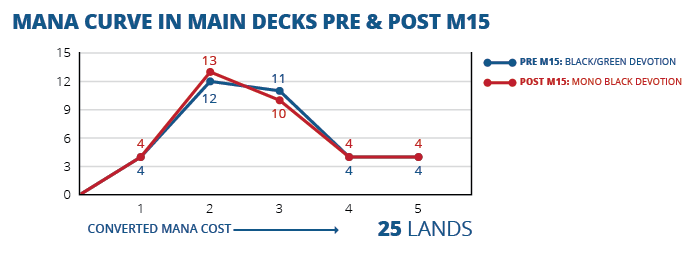
Previously, we had four Pack Rat to play on turn 2 regardless of what our opponent did, and other than that we had some combination of removal spells to
play on turn 2. This could in theory work out, and often it did–you could maintain tempo by using a removal spell at the end of their turn and follow it
up with another removal spell, a Lifebane Zombie, or an Underworld Connections as you saw fit. Now, we have effectively doubled the proactive
spells in our deck which means that more often than not we will be ahead in tempo rather than hoping to maintain it. The other benefit of having Sign in
Blood is simply that it helps you “un-mulligan.” As a tournament player, you can’t be “afraid to mulligan” because that’s irrational. You make the best
decision at each point in the game based on how much more likely it will make you to win the game. This includes mulligans. If you think your six-card hand
is less likely to make you win than the average five-card hand, you take the second mulligan. However, it is not necessarily irrational to include a card
that helps you when you do mulligan. Sign in Blood is this card.
Next, we have a singleton inclusion of the card Urborg, Tomb of Yawgmoth. This card, at first glance, appears to be all upside. However, it has a slightly
tricky part to it–it can help your opponent. Worse, it can help them a lot. Don’t get me wrong, most of the time you play this card it will help
you more than them, but there are conditions where you will regret it. For instance, most of their double Mutavault draws will get much better if you give
them the power of Urborg. Similarly, anyone playing Llanowar Wastes will get a bonus (more on this later). Lastly, against blue this can help them cast a
Nightveil Specter, so just be aware of what might happen. The reason it’s in the deck is to facilitate casting Sign in Blood and Bile Blight in the same
turn. It can also turn your own Mutavaults into black mana-producing lands. Swamp, Mutavault, and Sign in Blood are not really a combo, but Urborg,
Mutavault, and Sign in Blood are perfectly great together.
Now, I can’t take all the credit for this list as Gerry Thompson was kind enough to help me out as he always is. We came to it together with me stating
that I very much wanted to play Devour Flesh. I’m sure by now you’ve read numerous articles detailing the exact ups and downs of the card, but given the
location of the tournament I was attending and who I thought might be in attendance, and given that Hexproof won the last close-by Open event, I thought
having access to Devour Flesh might put me ahead. Owen Turtenwald himself advised me to cut the card, stating that while it is good against Blood Baron of
Vizkopa and Hexproof, and is generally always fine, it isn’t necessarily very good against Mono-Blue Devotion because you often can’t hit what you want,
and you can essentially never hit a Master of Waves if they’re careful. However, more than once I Devour Fleshed myself to help me out of a tight spot, and
giving up that functionality was an uncomfortable one for me. In addition to that, one of the highlights of the tournament other than the matches in the
top 8, which were all exciting (I think), was Devour Fleshing my opponent’s Erebos! It isn’t exactly “likely” to happen, but it was great when it did. Owen
recommended a full set of Bile Blights to me which is what I ran up against in the top 4 of the event. Bile Blight is a nice card, and with a little work
it can often pay dividends, but the reality of the card is that playing four is a mistake. It’s great against Pack Rat and good against blue. In game 1
against Supreme Verdict decks, it can handle Elspeth tokens in a pinch, but it is downright bad against Jund Monsters. I didn’t get paired against any Jund
Monsters during the ten rounds I played (one ID in round 8), but I was much more confident about that potential pairing given that I had functional removal
at my disposal.
While we’re mostly on the subject, I want to discuss Erebos. I think a lot of players view Erebos as a throwaway. They might say “It’s fine, it shines in X
and Y matchup, but something else might be better.” I don’t really think of it that way. I think it’s one of the single best cards in any kind of black
mirror, and I think it is perhaps the most important card you can put in your sideboard against the Supreme Verdict decks. I don’t necessarily think you
need to play Whip of Erebos to improve him (having non-creature sources of devotion is a great way to improve a god in Standard obviously), but if you
wanted to, I wouldn’t blame you. I faced off against two unique whips during the event and narrowly escaped defeat each time. It’s definitely a good card
and great in the mirror.
I took the fourth Underworld Connections out of the board in favor of one Dark Betrayal. We’re a long way from the days of sideboarding four Dark Betrayal,
and yet not that much has changed. I will say this for Dark Betrayal though: when you draw it is very easy to get your opponent. They won’t play
around a one-casting cost removal spell because there are so few Dark Betrayals going around which will (under the right circumstances) let you waltz them
into your trap. Ironically though, I wanted the one Dark Betrayal so that I could side it in against Mono-Blue Devotion! Blowing up Nightveil Specter is
such a big deal in that matchup that I feel having one Dark Betrayal in your deck against them is incredibly important, and I was happy I made the switch.
The fourth Underworld Connections would have been useful for me several times but maybe not more useful than a Whip of Erebos would have been. Food for
thought.
Now the cards that didn’t make the cut:
First, Stain the Mind. This card looks like Cranial Extraction or Memoricide to me, and indeed it’s roughly the same. Convoke on this card doesn’t do much
in this deck, but it’s nice to know that sometimes you’ll be able to jam this for four instead of five. There are also times (especially in the Supreme
Verdict matchups where you’ll be bringing this in) where you can’t necessarily attack with your creature for fear of Aziorius Charm–that makes convoke a
real bonus on this card. Indeed, if you’re expecting a lot of Supreme Verdict decks, this is a worthy inclusion–probably two copies. Resolving one with
the help of a Thoughtseize or a Duress probably isn’t that difficult, but I think naming Elspeth, Sun’s Champion or just Sphinx’s Revelation is
devastating. Going forward, with the addition of Urborg, I would expect Esper — not necessarily straight U/W to become more prominent since Hero’s
Downfall becomes a lot easier to cast when all of your lands are Arcane Sanctums.
Llanowar Wastes is the other card from M15 that I find to be most interesting here. At first, I thought okay, I don’t want that. I don’t want to pay a life
for black mana for most of the game. Then I thought okay, maybe it’s worth it — maybe just a couple. I wouldn’t mind cutting Golgari Guildgate and Forest
from the deck, so why not? Now I think it might be worth running all four and playing a second and maybe even a third Urborg. Urborg means that Llanowar
Wastes can make black mana free of cost which is great for everything you want to do. Of course, when you run so many Urborgs, you run into the problem of
drawing more than one, but the “new” legend rule mostly protects you, not to mention Pack Rat can help. The biggest downside of playing with the green
cards is that you really can’t have all your lands come into play untapped–Temple of Malady is pretty much a foregone conclusion, and while Temples have
been proven to be great, they do not mix particularly well with Sign in Blood. Same goes for Overgrown Tomb. You can definitely put Overgrown Tomb into
play untapped, but with Thoughtseize and Sign in Blood, I was not exactly long on life-total points; adding Overgrown Tomb into the mix makes that a
daunting proposition, but one that I would definitely advise thinking about for all of you attending the upcoming Pro Tour.
Finally, let’s take a look at some sideboarding options assuming you’re playing my list.
Let’s start with Jund and G/R Monsters. Lifebane Zombie will shine here and your combination of functional removal and Desecration Demons can leave them in
a tough spot. However, the games where they have Elf into Domri into Xenagos are hard to win. Xenagos itself is quite strong against you, and if you can
Thoughtseize it, you probably want to.
Out:
In:
I would consider another Sign in Blood out for another Duress in, perhaps especially on the draw where you’ll be starting off behind. Pithing Needle is, of
course, great against their planeswalkers and can, at a moment’s notice, turn a great draw from them into a mediocre one. They still have very limited
answers to your Demons and Duress helps even more in that regard, but it can also nab planeswalkers which is great. As I’m writing this, I think I’m
convincing myself regarding the second Duress so you should probably go that way.
Next we have aggro-creature decks. I can touch upon some of the less universally acceptable sideboard cards in my list here. Pharika’s Cure and Drown in
Sorrow were concessions to the possibly exceptionally difficult aggro matchups. I like Pharika’s Cure against Mono-Blue Devotion as well, and I considered
bringing in Drown in Sorrow on the play as well, since it can trade one for one with a Master of Waves I figured it might be worth it (although I did not
go that route, ultimately.)
In particular, the Boss Sligh deck which is both cheap and effective and scary to play against, was on my mind after my finals loss in
Columbus. I got to Pharika’s Cure an Akroan Crusader wearing a Madcap Skills at this event, so I felt pretty smart for a bit. Here’s what I’m doing against
hyper aggressive decks:
Out:
In:
There are considerations for bringing in Duresses and/or taking out more copies of Sign in Blood and/or Thoughtseize, as it’s tricky to know just how much
damage you want to deal to yourself. After our match we determined that my opponent had seventeen spells in his deck but while playing I couldn’t quickly
or effectively figure out if bringing in Duress was right, and I do believe you’ll have to do some on-the-fly-sideboarding to get it correct. The games,
luckily, are easy to navigate and taking out Lifebane Zombie is fine since it will always trade down or die a fiery death.
Against Naya Hexproof you have to keep in your Lifebane Zombies, and in exchange for this, the Pharika’s Cures and maybe even the Drown in Sorrows aren’t
that good in that matchup. Especially Drown on the draw is going to be too slow too often. You really need to mulligan to and draw your Devour Fleshes and
then use them wisely. But, it’s doable.
Against something like a black-aggro deck I would skip the Doom Blades and bring in one Dark Betrayal. Lifebane Zombie is unexciting, but it can trade and
block and your late game is just so much better that I’d do anything I could not to die in the early turns; I would expect to take over if that worked.
This is a matchup (black aggro) where having access to Golgari Charm is really nice, and if black aggro somehow crops up, that will be another push in the
direction of playing the green splash.
Then there is Mono-Blue Devotion:
Out:
In:
Five for three? Well, no, not exactly. I hope by now you know I would never recommend intentionally beginning a game with more than sixty or forty cards in
your deck, but I digress. I think that upgrading some of your expensive removal like Hero’s Downfall and turning it into cheaper removal might make sense.
I think that if you want to try to “get them” with Drown in Sorrow on the play that it’s doable, but I also think this matchup plays out vastly differently
on the draw than on the play, and that you should sideboard between games depending on who will have the first action. I can also see boarding out Gray
Merchant of Asphodel here, as it’s slow and while gaining life is good, it isn’t exactly the best blocker against them. Their creatures are either a swarm
of Elemental Tokens, unblockable due to Thassa, or simply flying to start. Giving up on that life “cushion” means you need to be careful and possibly point
the Devour Flesh at yourself rather than them. Take it slow and think it out, as it’s a good matchup.
Then there’s the mirror. Careful play and drawing well will take you far, but not all the way there. I think it’s slightly unrealistic to aggressively
mulligan to answers to a “good Pack Rat draw” (which probably consists of Rat and Thoughtseize). The problem is if you mulligan and they have that draw,
they still get to Thoughtseize you, so now you have a five-card starting hand size, which is pretty bad. I think with thoughtful play you can pretty much
extend your life long enough to try to draw into a Bile Blight, and if you don’t get there we can always try again next game. Here’s how I was
sideboarding:
Out:
In:
Before this event I was never boarding out any Gray Merchants, but I didn’t hate doing it as much as I thought I would — for the record though, starting
less than four is insane. The games are grindy, and the body is insignificant. If you have access to Whip of Erebos, then it becomes much more useful in
general, and I might approach the matchup differently, but since it’s hard to get things to stick, drawing a five mana 2/4 Highway Robbers is not exactly
the best (don’t get me wrong, it’s also not the worst).
In this matchup, and in the next, it’s important to remember that you simply can’t go “all-in” on Pack Rat. As I mentioned earlier my opponent had the full
four Bile Blights in the top 4 of the event, and I suspect that the reasoning behind it is sound enough that people might very well abandon Devour Flesh
(unless they read this article)! It’s really bad to suffer a Pack Rat blowout.
Finally we have Supreme Verdict decks. In the top 8 of the event I was paired against a U/W Control deck and got pretty well crushed game on after a
mulligan. At the time I was thinking, man, I should have played the green splash that I’ve used all along. But, the sideboarded games played out much
differently–better–and I was able to apply pressure at all the right points with judicious use of Thoughtseize, Duress, and Erebos.
Out:
In:
We keep Lifebane Zombie in as an unblockable way to pressure their life total as well as their planeswalkers, but this is also why I keep in Hero’s
Downfall. Sometimes Elspeth, Sun’s Champion is unassailable through combat and having a non-combat way to interact is important. All in all, my opponent
didn’t have Detention Sphere for me to Golgari Charm and there was basically no non-Deicide way to answer my Erebos for him. Granted, he did get to Deicide
Erebos in game 2, but I still managed to win. Planar Cleansing is slow; Quicken makes it faster, but it’s still a lot of white mana and a lot of mana in
general–it isn’t a given that they can cast it. It isn’t a given that it will be “good” for them when they do! I think Sphere will come back into
popularity before long though, and with it perhaps the green splash? I’m not sure. Why don’t you tell me what you think about splashing green in the
comments below?

